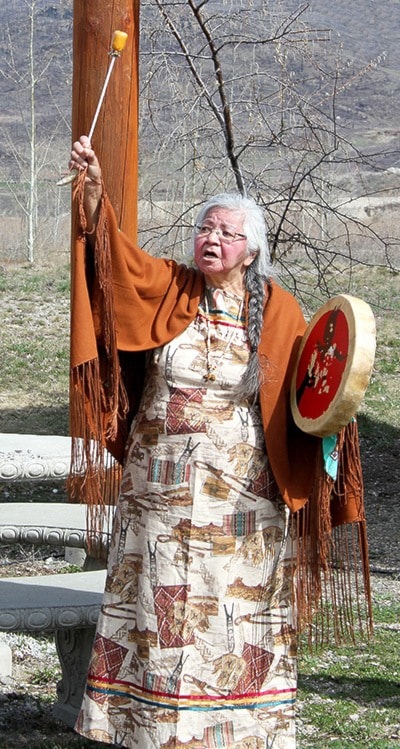The Secwepemc People:
The Secwepemc people are also know as the Shuswap. Historically, the Secwepemc Nation was made up of 32 bands. Today, due to diseases such as smallpox that wiped out thousands of people, there are only 17 bands that make up the Nation.
The Secwepemc people have a traditional territory that they live within, called Secwepemc’ulucw. They are united by a common language, Sewepemctsin, and a similar culture and belief system.
The traditional people were semi-nomadic, living in pit houses in the winter and in matt lodges made of reeds in the summer. The Secwepemc traveled around the territory to hunt, fish and gather berries and medicines. Today, many people still carry on the way of life that has been passed on for generations.
Drum (Pumin):
The drum represents the heartbeat of the Nation. The heartbeat of all living things in Creation. The round hoop that makes up the drum symbolizes the sacred hoop that we all live within. The life within, no beginning and no end. We are no better than anything else in Creation. We are all the same, everything has a spirit, and everything is sacred. All of these teachings come with the drum. You can pick up a drum and look at it and think about life and think about things that go on around you, that drum encompasses all of that.
The drum is the heartbeat of our oldest living relative, the Mother Earth and the Creator.
When we carry a drum, we respect it as an extension of our own self. It is used in prayer, ceremony, and celebrations or just for the simple pleasure and pure joy of singing.
Are there different songs and dances for the Band’s within the Secwepecm Nation?
There are different songs that each community owns, but from the way that most of the songs are being taught, it’s clear that they belong to the entire Secwepemc Nation. They don’t belong to one family, or one community, they belong to everyone within the Nation.
You don’t have to worry about protocol and asking permission, as long as you learn it by doing it, not by recording, not by videotaping it. You have to take the time to actually sing the songs yourself and do the dances yourself. That’s how you earn the right to sing and dance these songs.
Maiden song and Dance:
Men and women sing the song, but only the women dance. This is also a t’ey (women’s) dance. It was used to show off the young eligible women in the community.
The dance starts with all the maidens, the eligible women in the front. Behind them are the mothers, grandmothers, aunties, the ones who have husbands and kids. It’s almost like a line dance. All the maiden’s supporters are behind them. They dance forward with their hands on their hips. Doing t’ey steps. When they turn to the eligible men, they have their arms up in the air; hands open almost cradling the sky. That’s how they would present themselves to the young men. They would dance towards the young man of their choice.
The young man at that time would either accept or decline. If he accepted he took her hand, if he declined, he would turn his back to her. If he said no or declined her offer he maybe hadn’t finished his training, still had something to complete, or wasn’t ready to take on the responsibilities of being a man or a husband.
He didn’t decline the offer because she wasn’t pretty or because he didn’t like her, it was simply because he wasn’t ready to be a provider or a father. This dance was done at a National gathering of some sort.
Welcome Song and Dance:
The song welcomes guests to your community. It is sung if you’re in a new place like a berry picking patch or hunting area, that’s the song you would sing when you get there.
The dance that goes along with the song is called t’ey. T’ey is a woman’s step. The women dance this welcome song.
The way we were taught is the steps are really little, very feminine and dainty. The woman holds her hands on her hips. Raising her hands up to the sky, welcomes the son, the wind, the birds, anything up towards the sky.
Placing of hands on the heart and moving outwards with palms facing up, welcomes the people and the animals.
Moving the hands towards the ground welcomes the stream, and the rocks, everything on Mother Earth.
When you welcome people, you place both your hands on your heart and push your hands out towards the people.
Farewell Song and Dance:
A man and a woman can sing the song together. It originally was sung for people leaving your community. The meaning for Secwepemc was, “until we meet again”.
People sang it for someone leaving the community, ever for a short time, like an ets’xwem (fast on the mountain). After gathering at a berry picking spot, or when finished hunting in a specific area, this song was sung.
The dance is a t’ey, a woman’s step. Really small, really feminine steps with your hands on the hips, almost the same as the welcome song.
When you are moving your hands, your palms are face down. The hands never move down away from your heart.
Say farewell to the birds, the fish, and the deer, everything to do with Mother Earth or the people you are parting ways from.
As a people, we never had a word that says a final goodbye. We always believed we would meet again.
